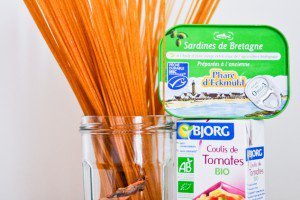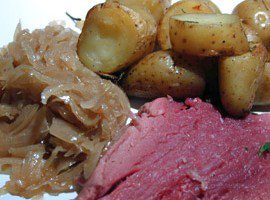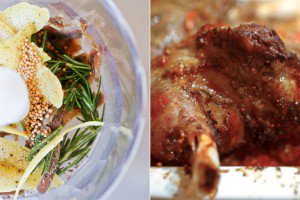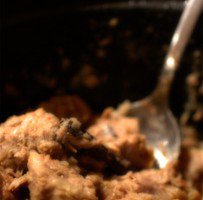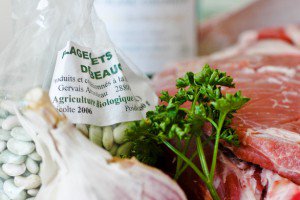We had our neighbors Stéphan and Patricia over for dinner last week to celebrate their respective birthdays, and it was as much a treat for me as it was for them.
Though it is a bit more of a challenge to cook multi-course meals now that I have a child — as all Parents Who Cook will no doubt agree — it is spectacular how refreshed and energized and just plain giddy I feel when I do get to spend quality time in the kitchen.
Favoring slow-cooking recipes for dinner parties
For dinner parties I’ve always favored make-ahead, slow-cooking recipes that require little active work, so that hasn’t changed, and as I discussed in this 5-question interview on Food52 last month, I have become a master of mise en place in both my daily, and my special occasion cooking.
Because each part of the meat is alternatively exposed to dry and wet heat, the whole cut remains very moist, while also developing an irresistibly caramelized outer crust.
This means I select recipes based on their ability to be sliced up into small steps that can be executed earlier in the day, the day before, or even two days ahead. And this recipe is a fine example.
Braised pork is exceptionally flavorsome: you place it in the oven in a shallow pool of liquids (here, white wine and tomato juice, or tomato water saved from roasted tomatoes), turning the meat regularly over the span of a few hours. Because each part of the meat is alternatively exposed to dry and wet heat, this method allows the whole cut to remain very moist, while also developing an irresistibly caramelized outer crust.
Amazing braised pork, broken down into make-ahead steps
And it is an ideal recipe if you want to spread out the different steps over two or three days; in fact, it is recommended that you do.
It is spectacular how refreshed and energized I feel when I do get to spend quality time in the kitchen.
On the first day, you’ll make a simple rosemary salt to rub onto the pork, and you’ll dice the flavoring vegetables (carrots, fennel, onion, garlic). The next day, you’ll cook the meat in the oven and let it cool, so you can skim the excess fat. Later that day, or the next day, you’ll reheat the whole thing and serve it to your very appreciative guests with the gremolata you’ll have had plenty of time to prepare because you were so un-tied up in the preparation of the meat.
As for sides, you can serve braised pork with mashed potatoes or a purée of celery root, but this time I served it with my current favorite blend of roasted vegetables: zucchini, cabbage, and sweet potatoes (with garlic, ground cumin, and olive oil), a mix I once serendipitously prepared based on what was left in the vegetable drawer, but which I’ve now purposely recreated a few times, so tasty it was.
Join the conversation!
Is braising a technique you like to practice with meat? And what’s your favorite “sliceable” recipe to prepare in installments for dinner parties?

Have you tried this? Share your pics on Instagram!
Please tag your pictures with #cnzrecipes. I'll share my favorites!
Ingredients
- the leaves from 3 small sprigs fresh rosemary, chopped (about 1 tablespoon chopped)
- 1 tablespoon fine sea salt
- a 2.2-kilo (5-pound) piece of braise-friendly, bone-in pork (such as the shoulder or spare rib) from a sustainable source
- 140 grams (5 ounces) carrots (2 small), diced
- 140 grams (5 ounces) fennel (1/2 small), diced
- 140 grams (5 ounces) yellow onion (1/2 small), diced
- 2 cloves garlic, finely chopped
- 1/2 cup white wine
- 1/2 cup tomato juice or vegetable stock
- gremolata, for serving
Instructions
- The night before (or 2 days before), combine the chopped rosemary and salt in a small bowl, and rub this rosemary salt on the pork on all sides. Wrap the meat tightly and refrigerate until the next day. You can dice the vegetables and chop the garlic at this point if you want to; place in an airtight conatiner and refrigerate.
- In the morning (or the day before), place the meat in a roasting pan large enough to accommodate it comfortably. Sprinkle the carrots, fennel, onion, and garlic around the meat. Pour in the white wine, tomato juice, and water as needed to come up to about 1/4 of the meat.
- Place in the cold oven and turn it on to 180°C (360°F). Cook for 3 1/2 to 4 hours, flipping the meat every 45 minutes or so, until well browned and fork-tender.
- Remove the meat from the pan, pour most of the cooking juices (without the vegetables) into a bowl, and return the meat to the pan. Let everything cool to room temperature, and place the bowl and pan, covered, in the refrigerator.
- About 1 1/2 hours before dinner, remove the bowl and pan from the refrigerator. Skim the fat from the bowl of cooking juices (keep this good fat and use it to fry eggs or roast vegetables) and let the meat come up to room temperature, about 1 hour.
- Preheat the oven to 150°C (300°F). Scoop the remaining, gelled cooking juices into the pan. Return the pan to the oven to reheat, about 20 minutes, carve, and serve with the cooking juices and a sprinkling of gremolata.
This post was first published in September 2013 and updated in January 2016.




